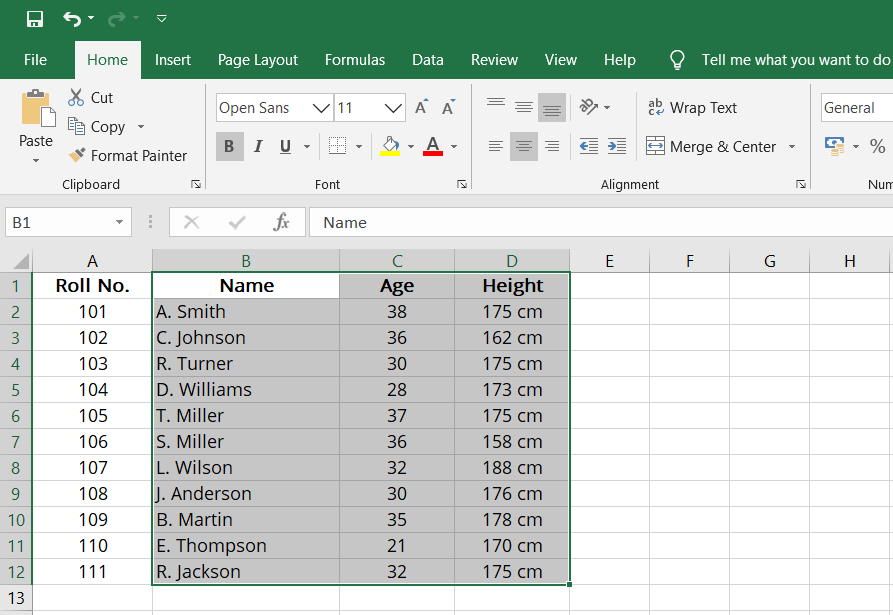

Say goodbye to having to use third party drivers before connecting to external data in Excel for Mac. Note that the WebService, EncodeURL and FilterXML functions are not available yet in Excel 2016 for Mac. Why not have a try on the Arabic function (for example, try =ARABIC(“LVII”)) and see what you get.
Excel for mac select all windows#
In Excel 2016 for Mac, we’ve added almost all new formula functions in Excel 2013 from the Windows platform. We worked hard to ensure your workbook is compatible and works seamlessly across platforms as often as possible. If you want to customize a keyboard shortcut, you can refer to the steps in this article: Create a custom keyboard shortcut for Office 2016 for Mac. On the Keyboard tab, select the Use all F1, F2, etc.Go to Apple > System Preferences > Keyboard.If you don’t want to press the fn key each time, you can change your Apple system preferences: Note that if a function key doesn’t work as you expect, then press the fn key in addition to the function key. Some popular shortcut keys are listed below a complete list can be found here. This even works on your Mac laptops, where delete is actually the backspace key. If you want to clear the content of the selected cell or range, just press the delete key. Windows users will rejoice that Windows key assignments like Ctrl+O for Open, Ctrl+F for Find and Ctrl+C for Copy now also work in the Mac version-no need to remember to press Cmd instead of Ctrl. That’s why you’ll notice an interface consistent with Office 2016 for Windows and why we added support for virtually all of the Windows Excel keyboard shortcuts. When building Office 2016 for Mac, one of our key objectives was to make it as easy as possible to transition from using Office for Windows to using Office for Mac and back again. The Data Analysis ToolPak is now on the ribbon under the Data tab. To enable this add-in, under the Tools menu, click Add-Ins, select Data Analysis ToolPak and then click OK. Some tools generate charts in addition to output tables. You provide the data and parameters for each analysis, and the tool uses the appropriate statistical or engineering macro functions to calculate and display the results in an output table. Still looking for the Data Analysis ToolPak in Mac Excel? It’s finally here! Data Analysis ToolPak is an Excel add-in that helps develop complex statistical or engineering analyses. To filter the PivotTable data, simply click one or more of the buttons in the slicer. Creating a slicer is easy-just select the PivotTable you want to filter, and then on the ribbon, under the PivotTable Analyze tab, click the Insert Slicer button. It contains a set of buttons allowing you to find the items that you want to filter without the need to open drop-down lists. Slicers enable you to filter the data in a PivotTable report. To use the Formatting task pane, on the ribbon under the Format tab, click the Format Pane button or press Cmd+1 while a chart element is selected. With this single task pane, you can modify not only charts, but also shapes and text in Excel!

The new Formatting task pane is the single source for formatting-all of the different styling options are consolidated in one place. One part of this fluid new experience is the Formatting task pane. To access the Formula Builder, simply click the fx button on the Formula bar or press Shift+F3.Įxcel 2016 for Mac offers a rich set of features that make creating and customizing charts simpler and more intuitive. It allows you to search and insert a function, add data to defined function arguments, and get help on any function. With the Formula Builder in Excel 2016 for Mac, building formulas just got simpler. If you’ve ever had trouble remembering Excel functions or syntax, the new Formula Builder makes it easy.

To see a collection of suggested chart types, select a cell in the range of data you want to visualize, and then on the ribbon, under the Insert tab, click Recommended Charts. This feature allows you to see how selected data would be visualized on a variety of chart types before committing to one in particular. Let Recommended Charts take some of the pain away. Recommended ChartsĬhoosing a chart type to best represent your data is often challenging.


 0 kommentar(er)
0 kommentar(er)
